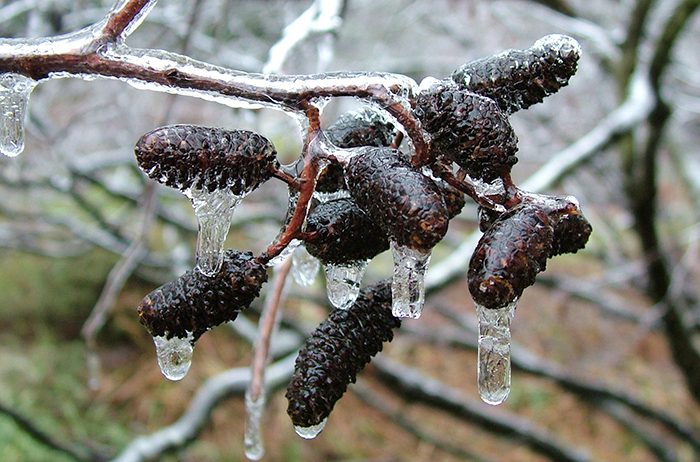
Photo by Jason Holmes.
Botanical name: Alnus serrulata
Common name: Hazel alder
Family name: Betulaceae (Birch Family)
Plant type: Shrub or small tree 10 to 20 feet tall
Native range: Eastern U.S.
Bloom time: February to March
Location within Duke Gardens: Blomquist Garden of Native Plants
USDA Hardiness Zones: 4-9
Growing conditions: Partial shade; tolerates mesic to wet soil. Grows well in wetlands, streams and river banks.
This has to be one of my favorite plants in the Blomquist Garden. It is a landscape workhorse. For most of the year it is an innocuous, multi-stemmed, large deciduous shrub or small tree that grows to form extensive thickets by colonizing stream banks and wetlands from Nova Scotia to northern Florida. The trunks are gray and smooth and are said to possess a bitter astringent taste. A tea made from the bark has a history of medicinal uses.
During late winter, separate male and female catkins are formed on the same tree before the leaves emerge. Slender, cylindrical male catkins 2 to 4 inches in length and displaying brownish-yellow flowers dangle in clusters close to the branch tips. At the branch tips, smaller female catkins, each up to ¼-inch long and having the appearance of rubies, sit in clusters. These female flowers are wind pollinated and eventually will develop into small fruiting cones called strobiles that contain nutlet seeds. The fruiting cones resemble tiny pine cones and gradually take on a dark brown hue in the autumn. These cones persist into the winter and are a source of food for birds.
Alnus serrulata has simple, obovate leaves (the shape of teardrops with wedged shaped bases) and measure 2 to 5 inches long and 1 to 3 inches wide. Hazel alder has dull, green leaves with prominent feathery venation, a smooth upper leaf surface and a hairy texture on the underside. The leaf margins are serrulate (saw-like), hence the specific epithet serrulata.
Although not a legume, plants in the Alnus genera fix nitrogen. They are actinorhizal plants, forming a beneficial symbiotic association with a filamentous bacterium called Frankia alni. Due to this nitrogen fixing ability and its fibrous root system, the hazel alder is used to stabilize stream banks and prevent soil erosion.
